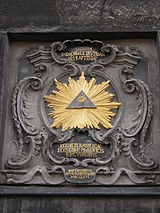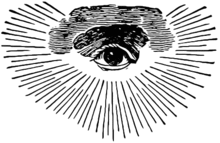Eye of Providence

The Eye of Providence or the all-seeing eye is a symbol showing an eye surrounded by rays of light or a glory, and usually enclosed by a triangle. It is commonly interpreted as representing the eye of God keeping watch on mankind (see Divine Providence).
Origin
In its current form, the symbol first appeared in the west during the 17th & 18th centuries, but representations of an all-seeing eye can be traced back to Egyptian mythology and the Eye of Horus. 17th-century depictions of the Eye of Providence sometimes show it surrounded by clouds. The later addition of an enclosing triangle is usually seen as a more explicit trinitarian reference to the God of Christianity.




United States
In 1782 the Eye of Providence was adopted as part of the symbolism on the reverse side of the Great Seal of the United States. The Eye was introduced by the original design committee of 1776, and is thought to be the suggestion of the artistic consultant, Pierre Eugene du Simitiere.
On the seal, the Eye is surrounded by the words Annuit Cœptis, meaning "It [the Eye of Providence] is favorable to our undertakings". The Eye is positioned above an unfinished pyramid with thirteen steps, representing the original thirteen states and the future growth of the country. The combined implication is that the Eye, or God, favors the prosperity of the United States.
The Great Seal is used to endorse official United States documents. As such, it is reproduced, along with the Eye of Providence, on the back of every one dollar bill.

Freemasonry
The Eye of Providence also appears as part of the iconography of the Freemasons. The all-seeing eye is then a reminder that a Mason's deeds are always observed by the Grand Architect of the Universe. Typically the Masonic Eye of Providence has a semi-circular glory below the eye — often the lowest rays extend further down. Sometimes the Eye is enclosed by a triangle, but here this is seen as a reference to the Freemason's preference for the number three in numerology. Other variations of the symbol can also be found, with the eye itself being replaced by the letter ‘G’, representing the Grand Architect.
The first official Masonic reference to the Eye of Providence is in The Freemasons Monitor by Thomas Smith Webb in 1797, some years after the Great Seal was designed. The Masonic use of the Eye does not incorporate a pyramid, although the enclosing triangle is often interpreted as one.
It is a popular urban legend or conspiracy theory that the Eye of Providence and unfinished pyramid show the influence of Freemasonry in the founding of the United States. This was recently dramatised in the Disney film National Treasure.
Among the original design committee for the Great Seal of the United States, only Benjamin Franklin was a Mason, but his ideas were not adopted by the committee and he may not even have been aware of it. All of them had a great deal to do with the setting up of the American way (Democracy, etc.). Many masonic organisations have denied any special connection. This applies to the original creation of the Seal, but not the 1935 decision to include it on the one dollar Federal Reserve Note. The Scottish Rite Journal website quotes Henry A. Wallace as follows, saying he brought a picture of the Great Seal to the President after seeing it for the first time: Roosevelt, as he looked at the colored reproduction of the Seal, was first struck with the representation of the all-seeing eye—a Masonic representation of the Great Architect of the Universe. Next, he was impressed with the idea that the foundation for the new order of the ages had been laid in 1776 but that it would be completed only under the eye of the Great Architect. Roosevelt, like myself, was a 32nd Degree Mason. He suggested that the Seal be put on the dollar bill. [1] Iowa State University has in its collection a photocopy of a one dollar bill bearing the words “A Token of the New Deal. Henry A. Wallace”. [2]
Virgin of Garabandal
According to some sources [citation needed]during an apparition of the Virgin Mary at the village of Garabandal, she was seen next to a flaming Eye in the Pyramid.
UFO Lore
According to some UFO witnesses, there have been several sightings of Men in Black wearing a symbol resembling the Eye in the Pyramid, sometimes with a lightning bolt through the eye. This symbol can often be found on their cars or lapels.
Cao Dai
The Vietnamese religion Cao Dai, as well as a number of other churches, uses the Eye of Providence (specifically, the left eye) within a triangle to represent God.
Illuminati
Today some conspiracy theorists link the symbol with conspiracy organizations, especially Adam Weishaupt's Bavarian Illuminati. This is possibly the only context in which the Eye of Providence is shown actually embedded in a pyramid. The eye is meant to be the eye of Lucifer.
Current and recent usage

- Great Seal of the United States
- Several American organisations also incorporate the Eye of Providence in their logos, through association with its use on the Great Seal
- Dollar bill
- Former logo of the Information Awareness Office
- Steve Jackson Games
- The Eye of Providence was formerly the logo of Time Warner prior to its merger with AOL
- The logo of The All-Seeing Eye. A computer software application designed to help Internet gamers find game servers.
- In The Lord of the Rings, Sauron is described as having an all seeing eye. In the Peter Jackson trilogy, Sauron himself is physically manifested as an eye.
See also
- Eye of Horus - an Ancient Egyptian symbol of protection and power.
- The Third eye common to Buddhism, Hinduism, Surat Shabda Yoga and Rosicrucianism.
- Odin - One eyed due to his quest for knowledge.
- Evil eye - widely distributed element of folklore or superstition.
- Eye of Sauron - from J. R. R. Tolkien's Lord of the Rings books.
- Seeing Eye - guide dog training school.
External links
- Rosslyn Templars a modern Freemason's debunking of the myth of a connection between Freemasonry and the Great Seal of the United States.
- grand lodge of British columbia and yukon - response to claims of masonic origins of symbol
- grand lodge of British columbia and yukon - graphics from the kneph
- wealth4freedom.com/dollarbill - collection of links regarding the symbol and discussion regarding them
